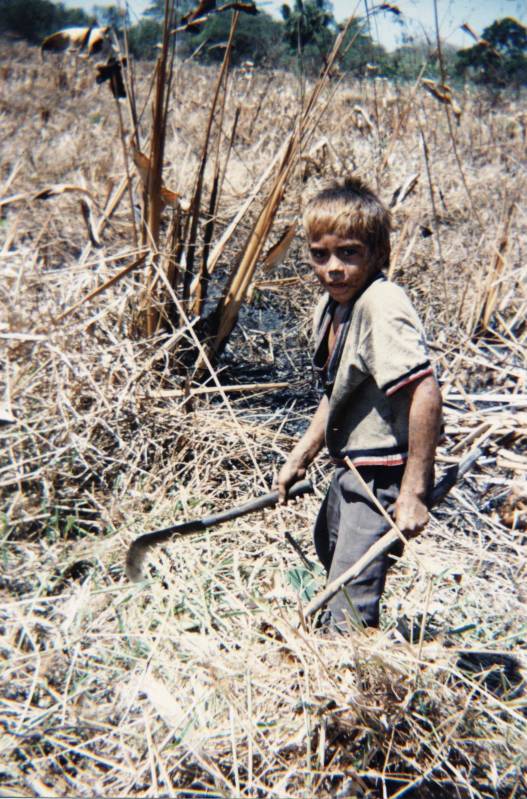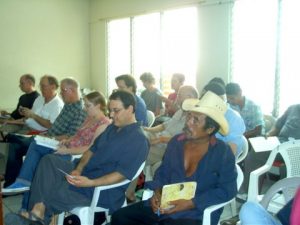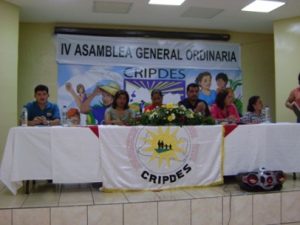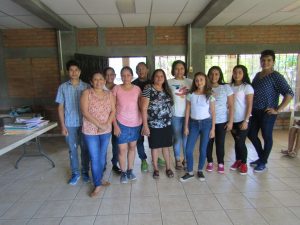CRIPDES Regional Support, Defending Natural Resources
The changes we want from the sugarcane industry
The upcoming year Sister Cities, through the Philadelphia Committee and the Climate Change working group, will support initiatives to raise awareness about the link between bad practices in the sugar cane industry, including the use of chemicals such as glyphosate in its production, and the number of people diagnosed with kidney disease and kidney failure.
This is an issue that communities in the Lower Lempa have been dealing with for several years. Politics have always gotten in the way of reinforcing environmental ordinances once and for all, while many people of lower income have suffered and died of kidney failure.
In 2015, Lance Laver wrote the following report after visiting Las Anonas. We are sharing it now so more people can learn about this topic.
Sugar Cane Farming Report for CRIPDES / USESSC “No to Harmful Sugar Cane Practices” Campaign
By Lance Laver
In July 2015, the Philadelphia Interfaith Community Building Group, including members of the Philadelphia Romero Interfaith Center and U.S.-El Salvador Sister Cities, made its eighth trip since 1997 to the San Vicente Region of El Salvador—and fourth to our sister city of Las Anonas de Santa Cruz—to work with the people in the village on construction of some of the 25 latrines the group had funded to provide needed sanitation services to various families.
During this trip, we learned some chilling realities about sugar cane farming in the region and the deleterious effects of agro-business practices on human health and the environment—and of the CRIPDES “No to Harmful Sugar Cane Practices” campaign now underway there. The following report includes notes from a meeting on 7/8/15 and field observations with CRIPDES (a grassroots nonprofit serving ~300 families in seven departments in El Salvador, including San Vicente) on this subject. The report also includes additional notes from a subsequent Internet search to amplify some of the primary points made during this session. Although the session and notes focus on Las Anonas and the Lower Lempa region, many of the observations are typical of conditions throughout the country.
The purpose of this report is to provide information to people in the USESSC realm about sugar cane realities and muster support to help in the CRIPDES campaign to overturn these damaging practices.
***
Harmful sugar cane growing and harvesting practices are taking a huge toll on human health and the environment in rural El Salvador.
Although municipalities and health officials have recognized the effects of these practices—such as chemical spraying, burning of fields, diversion and pollution of water sources and deforestation, including grave kidney disease, killing of native plants, de-certifying of neighboring organic farms and damage to rural infrastructure/roads, the agro-businesses controlling the fields continue these practices.
Tecoluca is the first municipality to pass an ordinance for regulating cane sugar production (2Q 2015), which CRIPDES will try to help enforce; however, national laws override local ordinances and prohibit certain bans, including banning chemical spraying. (See “Chemicals” below.)
On 3/30/15, the Minister of Agriculture came out to help with the ordinance; however, there are some ongoing problems.
Sugar Cane operations issues:
- Separation: Sugar cane fields must be a minimum of 300 meters away from any houses; however, in Las Anonas some houses are six meters away from the fields.
- Harmful practices: Sugar cane companies have been present in the area since 2000-01 and have established some cost-saving practices that deleteriously affect the environment and human health. (1)
- Chemicals
- One such practice is air spraying of chemicals on the fields, affecting native fruit trees and vegetables, like squash, an important part of the local diet. Native varieties are dried out and killed by the chemicals and can no longer grow in the contaminated soil.
- The chemicals sprayed include agents that kill the plants slowly. The plants, trying to survive, produce more sugar. This chemically induced cycle is shorter than a natural one, so the companies can reduce the sugar growing-to-market time, sell more sugar and realize greater profits. With this approach, the plants will reproduce for three years, when manual replanting is needed. (Without the chemicals, the plants reproduce every five years before replanting is required.)
- In 2014, El Salvador made an agreement to export sugar to China; however, the 2014 crop was not good, so companies are under pressure to further minimize growing/processing time to increase the 2015 output to achieve the agreement quotas. (2) (See also “Quotas” below.)
- The chemicals have serious medical consequences for farm workers. Many young people working in the Salvadoran fields during this spraying suffer kidney failures that require ongoing dialysis (including recently one 21-year old man with advanced kidney failure); and all sugar cane-producing countries have high rates of kidney disease. (Note: Sugar companies are required by the Tecoluca ordinance to obtain permission from the local village community council before spraying, a regulation the companies have ignored. Besides people getting sick—workers and those living nearby—the field animals, including snakes, armadillos and possums, try to run away, but some do not make it.) Although the government is now providing “free” dialysis to affected citizens, the cost of traveling from the villages to towns and back multiple times a week for this treatment is often prohibitive. MOPAO (Movimiento Popular de Agricultura Organica) will forward medical statistics to USESSC. (3) (4)
- Forty percent of the chemicals remain in the sugar after processing, affecting people in El Salvador and internationally who ingest the sugar wholly or in any number of processed foods. Sixty percent of the sugar is exported.
- Burning of fields: Similarly, burning of the cane fields at the end of each growing season—a less expensive method than manual labor to separate the cane from the rest of the plant—also destroys any other crops in the area. Although this approaches simplifies final cane harvesting, burning leaves a scorched earth, killing native plants and causing harm to children, pregnant women and livestock. Note: The local Tecoluca ordinance mandates a minimum 24-hour pre-notification for burning—not currently followed. (5)
- Effect on neighboring fields: In addition, farmers in the area who are trying to grow sustainable, organic produce, are adversely affected. One cashew grower in Las Anonas, Alberto Climaco, saw his organic cashew fields de-certified by the local organic cashew plant because of the residual effect of sugar cane chemical spraying and burnings—and this is not an isolated case. Another local woman also lost her certification to produce organic cashews for similar reasons.
- Water: Besides polluting underground water sources with chemical drops, the sugar cane companies are pumping out and diverting public water from rivers and streams to irrigate their nearby fields. This practice dries out the water sources and makes “free” water less available to campesinos for their own farming. A recent study found a decrease in fresh water and increase in salt water, making the crisis more extreme. Furthermore, there are continuing efforts to privatize water, which would further disadvantage indigenous people.
- Deforestation: Agro businesses are cutting down trees with impunity to provide additional land for sugar cane fields. This practice leads to erosion and encourages droughts and flooding, including dissipating the underground water supply.
- Effect on road infrastructure: The constant movement of company trucks in an out of the community causes dust to kick up, impacting respiratory health and causing damage to the dirt roads. The companies pay nothing for road maintenance, and the village does not have the budget for road maintenance under these circumstances (although Las Anonas anticipates limited funding from the municipality for periodic watering and other road maintenance, but insufficient to pay for paving the roads).
- Wages: Sugar cane field workers typically receive $5/day for work generally beginning at 4:00 am and running to 12:00 pm—except during the harvest season when workers stay in the fields all day. (6)
- Effect on other plants/land uses: Besides the deleterious effects of chemical spraying and burning, sugar cane farming “sucks out the nutrients in the soil” so that no other plants can grow in sugar cane fields, even after sugar cane growing stops. In effect, the land “will be dead,” except for growing (contaminated) grass for cattle. The few trees remaining also will die from the spraying.
- Quotas: Per CAFTA, countries have certain export quotas. El Salvador “covers its butt” with sugar cane exports. (Most production is in the low flatlands, including the San Vicente Department / Las Anonas region, where cotton formerly was produced.)
- Land distribution: Although the land was redistributed after the Civil War, local property owners have needed to sell or lease their land to the large sugar companies—as the people can make more money than by growing corn themselves. Thus, the land, under the sugar companies, is functioning much like the former cotton plantations. Apparently, none of the sugar cane land adjacent to Las Anonas is owned locally anymore.
It is important to raise awareness among people working in the fields of these issues. CRIPDES is starting a “No to Harmful Sugar Cane Practices” campaign that U.S.-El Salvador Sister Cities and the Philadelphia Romero Interfaith Center will help publicize.
We then visited a sugar cane field and witnessed the effects of the crop burnings on the land.
People see sugar cane farming as a necessary evil (95% of the Las Anonas population has worked in the sugar cane fields); however, they demand accountability, including:
- Practices in harmony with the environment.
- Water regulation.
- No burning (cut instead when green).
The campaign may include the following:
- International support. (The Minister of Agriculture says international support is needed to change the current practices.)
- Boycott and stop eating processed sugar.
- Break up the Salvadoran agro-companies’ monopoly on sugar cane farming.
- Write to thank the Tecoluca municipality for passing its sugar cane ordinance and encourage the legislators to work also to change national laws regarding these practices.
- Write to the Minister of Agriculture and Minister of the Environment. Multiple outpourings of international support can help deter deleterious sugar cane practices. (CRIPDES will forward contact information.)
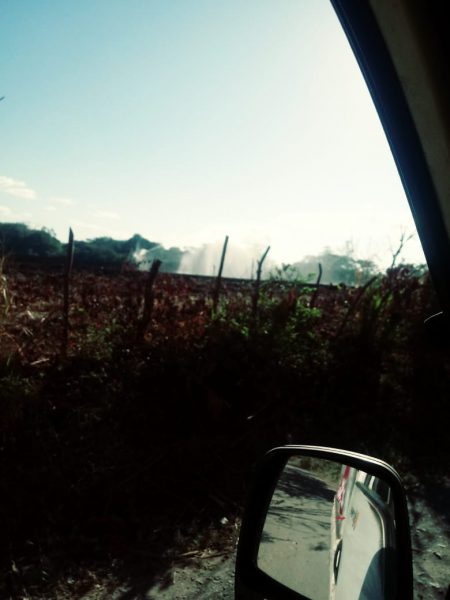
Notes
(1) Per CRIPDES, Large Salvadoran agro businesses, including El Jiboa, La Cabana, Chaparrastique, Central Izalco and El Ángel, own the fields and control the sugar cane industry. Investors also are remote; and minimum land purchases are 40 acres.
(2) According to Central Law – Regional News, “El Salvador: Sugar Exports to China” (2/23/15):
“Preparations are being made for the first export in the next few weeks of 50,000 tons of sugar, after the Asian country gave El Salvador approval for an import quota in December.
This shipment to China represents more than 10% of the production of exportable sugar in the country, as currently 60% of domestic production is exported and 40% is for local consumption, which has not changed its demand in recent years.
The manager of the Sugar Association of El Salvador, Julio Arroyo, told Laprensagrafica.com that “…The trade agreements signed by the country allow access for this product, one of the most restricted in the world with preference to certain markets. This year the export quota under the Association Agreement with the European Union will be 25,783 metric tons. And the quota which is part of the US commitment to the World Trade Organization could increase this year, but notification will not be given until April.
“…The current harvest ends in April, and according to projections by the union, this could represent an increase of up to 4% compared to last year. In 2014, 720,000 tons were produced. Currently El Salvador exports the product to markets in other parts of Asia, including South Korea and Taiwan. Other important destinations are the United States, Mexico, Canada, Indonesia and the European Union.” [link]
Per Voices on the Border—Information and Analysis from El Salvador: “The Bitter Taste of Sugar” (2/6/13):
“…The economic growth enjoyed by the sugarcane sector must be contrasted with the tragedy lived out by the communities located in regions where production has expanded. One of the regions most affected by mono-cultivation of sugar is the Lower Lempa region of Usulután. The local population has denounced the destruction of biodiversity, consumption of water sources, depletion of agricultural land, destruction of traditional campesinos agricultural traditions, and the health of the people exposed to agrochemicals and the methods used to spray them.
The Confederation of Federations of Salvadoran Agrarian Reform (CONFRAS) recently completed a study that included the Lower Lempa that determined that the cultivation of sugarcane uses at least eight different pesticides. Among them are Glyphosate, which is a controversial herbicide that environmentalists around the world would like to see banned.
READ ABOUT HOW BAYER WAS ORDERED TO PAY TO A COUPLE WHO BLAMED THEIR AG’S GLYPHOSATE-BASED WEED KILLER, ROUNDUP, FOR THEIR CANCER
This is one of the reasons that the Lower Lempa reports high rates of kidney disease, a problem evidenced by the result of a 2009 study completed by doctors from the Kidney Institute of Havana, Cuba. Their investigation revealed that 11 of every 100 residents of the Lower Lempa were suffering from kidney disease, and that in the Community of Ciudad Romero 30 people had already died with the past three years. The large majority of cases are reported in men—25.7% of men tested were positive for kidney problems, while only 11.8% of women tested were positive. Cuban nephrologist Carlos Orantes led the study [and] explained at the time that the problem is associated with a variety of factors, among them is agrochemicals.”
(4) “Over the past 20 years, more than 20,000 people in Central America have died of a kidney disease of undetermined origins, most of them cane workers.” (Christian Science Monitor.com – In El Salvador’s sugar cane fields, small changes bring new hope for workers (6/14/15) – link)
(5) “The real problem for the communities is the burning of the sugarcane fields…to increase production of the workers who cut the cane by reducing the end precut to the cane by burning off the unnecessary green leaves so they are not shipped to the plant. Ricardo Navarro from CESTA/Friends of the Earth stresses that the burning process has the highest environmental costs in that it destroys the soil and biodiversity, alters the local microclimate, contaminates the air, and generates greenhouse gases. The Sugarcane Producers Association of El Salvador, however, has said that the environmental impact of sugarcane production is positive. He [sic] says on the Association’s website that ‘planting a hectacre of sugarcane is the same as planting two hectacres of native forest.’”(Voices on the Border – Information and Analysis from El Salvador: “The Bitter Taste of Sugar,” 2/16/13 – https://voiceselsalvador.wordpress.com/tag/salvadoran-association-of-sugar-producers/)
(6) José Rene Bonilla has been cutting sugar cane for five years in El Salvador and would consider other employment if it were an option. “‘You lose your life doing this work, and you gain nothing’, he says….Most cane-cutters here are working to make enough monthly to plant corn, beans, and other food for their families’ consumption in the off-season. They report daily salaries between $5 and $15. It can add up to more than double the minimum wage of $114 a month – but the cutting season only lasts six months.” (Christian Science Monitor.com – In El Salvador’s sugar cane fields, small changes bring new hope for workers (6/14/15) – link)

